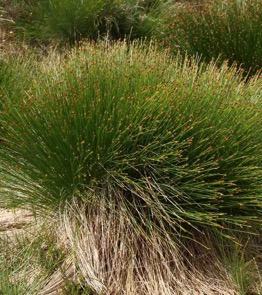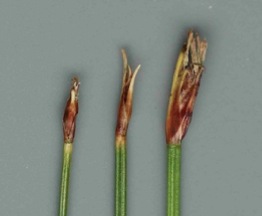
Tuft of T. germanicum
Young spikes of (from left) T. cespitosum;
the hybrid; T. germanicum
Ripe nuts in spikes of T. cespitosum
The genus Trichophorum
This page is for the genus itself. For separation of the UK species and hybrid, go straight to the flow-chart ⇒Field ID ~ 1, or to the individual taxa pages from the menus.
Download a simple ⇒Field-guide to the three Trichophorum taxa [PDF 85 KB; opens in a new window]. Print it to take out into the field (…mire/bog!).
Deergrasses
Rhizomatous perennial sedges, with varying dependency on damp soils, but rarely emergent from water. Two species extant in Britain, and their hybrid.
Growth-forms vary between very strongly, densely tufted (especially in T. germanicum) and laxer, or loosely tufted, or even with scattered stems (in T. cespitosum).
Stems extremely tough and wiry when mature, rounded in section, arising vertically, but typically then splaying out, with the outermost stems often eventually prostrate; often flexuous in some forms of T. cespitosum.
All shoots potentially flower, although inflorescences often abort to leave ‘blind’ stems. Leaf-blades are greatly reduced, the uppermost stem-sheath carrying a short blade about 1 cm long (as distinct from ⇒Eleocharis, in which only blade-less sheaths occur).
The internal structure of the stem is strikingly different between the two species (see the stem ⇒cross-sections and ⇒vertical-sections pages). ⇒Hybrids are however variously intermediate.
The stem is terminated by a single spikelet (for which “spike” might be a preferable term). This is small and few-flowered, each flower behind a glume, with a longer glume-like basal bract which encloses and largely protects the spike.
Flowers are bisexual, with three stamens, and a three-forked stigma. On maturity, glumes eventually fall, leaving the fruits – nuts – exposed.
The perianth is reduced to a few (5-6) bristles at the base of the ovary, which do not elongate in UK species after flowering (unlike in the cottongrasses, Eriophorum, in which the bristles make the familiar head of ‘cotton’ in fruiting *).
The hybrid is sterile; it produces pollen (viable?) in abundance, but its nuts fail to develop.
In some populations of both T. germanicum and the hybrid a proportion of the flowers may become proliferous (i.e. producing small plantlets).
* A third species, the boreal ⇒T. alpinum (Scirpus hudsonianus), was known at a single site in Scotland but lost by 1813. The bristles elongate in this species, making a tiny version of a ‘cotton-grass’.
Links to other pages
Summary pages
Identification pages
Other information
